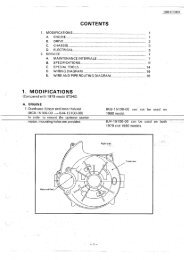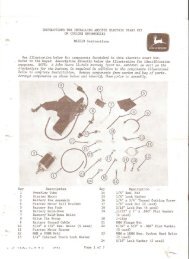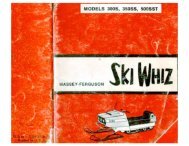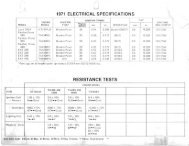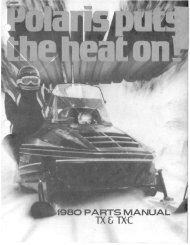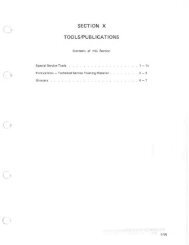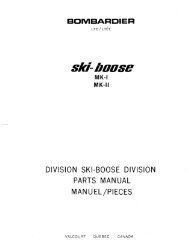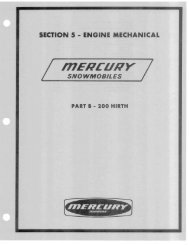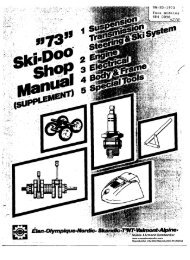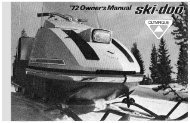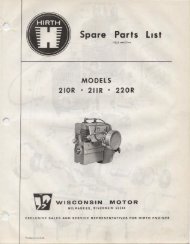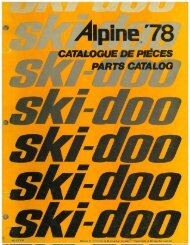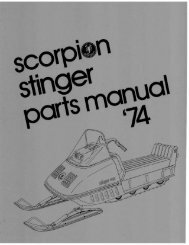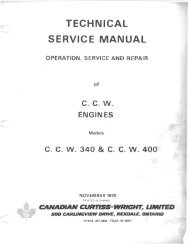Create successful ePaper yourself
Turn your PDF publications into a flip-book with our unique Google optimized e-Paper software.
<strong>HIRTH</strong> <strong>MOTOREN</strong> 1--
Technical data<br />
Engine output<br />
Direction of rotation<br />
Bore<br />
Stroke<br />
Cylinder displacement<br />
Point gap<br />
Ignition timing<br />
Recommended spark plug<br />
for high load<br />
Spark plug gap<br />
Ignition unit<br />
Hirth Type 190 R<br />
16 DIN H.P. at 5000 R.P.M.<br />
Counter-clockwise in view of Power Take-Off<br />
Shaft.<br />
75 mm. 2.95 ins.<br />
68 mm. 2.67 ins.<br />
300 ccm. 18.30 cu. ins.<br />
0,4 ± 0,05 mm (0.0157 ± 0.002 ins.)<br />
to be set<br />
when engine is not running:<br />
7 ~ before TDC equal to 0,50 mm (0.020 ins.)<br />
advances automatically<br />
when engine is running:<br />
25 before TDC equal to 3,95 mm (0.156 ins.)<br />
Champion UK 10 or Bosch M 225 T 1 or<br />
Bosch MV 225 T 1<br />
0,4-0,5 mm (0.0157-0.020 ins.)<br />
Bosch dynamo magneto ignition with advance<br />
timing<br />
Caracteristlques techniques -<br />
Hirth Type 190 R<br />
Puissance<br />
Sens de rotation<br />
Alesage<br />
Course<br />
Cylindree<br />
Ecartement aux vis platinees<br />
Reglage d'allumage<br />
Bougie recommandee<br />
pour charge forte<br />
Ecartement des electrodes<br />
Allumage<br />
16 PS DIN a 5000 t/m<br />
a gauche en regardant l'arbre moteur<br />
75 mm (2,95 pes)<br />
68 mm (2,67 pes)<br />
300 ems {18,30 pes cu)<br />
0,4 ± 0,05 mm (0,0157 ± 0,002 pes)<br />
doit litre ajuste<br />
quand me moteur ne marche pas:<br />
7 avant le PMH, egal 0,50 mm (0.020 pes)<br />
avancant automatiquement<br />
quand le moteur marche :<br />
25° avant le PMH egal 3,95 mm (0.156 pes)<br />
Champion UK 10 ou Bosch M 225 T 1<br />
ou encore Bosch MV 225 T 1<br />
0,4-0,5 mm (0,0157-0,020 pes)<br />
volant magnetique Bosch avec bobine lumil~re
Dismantling the engine - 190 R<br />
1. Dismount engine from vehicle and remove attaching<br />
parts. Remove electric starter if one has been installed.<br />
2. Mount engine on bench vice by using mounting angle<br />
w 115.<br />
Fan housing<br />
3. Remove fan housing complete with recoil-starter by<br />
removing the socket head cap screws.<br />
Fan Wheel<br />
4. Screw on holding device for fan wheel W 116 with the<br />
2 cylindrical head screws belonging to it, to crankcase.<br />
Remove catch piece with security plate for<br />
recoil starter by loosening the 3 cylindrical head<br />
screws with ell ern type wrench 5 01 N 911. Remove<br />
cover plate which is installed behind it.<br />
5. Loosen hex. nut, which is used to fasten the fan wheel,<br />
with a socket wrench (wrench size 24 mm).<br />
Apply fan wheel puller with the 3 hexagon bolts to<br />
the 3 threads of the fan wheel, tapped for this purpose.<br />
Lift off fan wheel by turning thrust screw of puller to<br />
the right. Remove holding device in order to allow for<br />
the removal of the fan wheel. (Illustration 1)<br />
Demontage du moteur - 190 R<br />
1. Depose du moteur - depose des accessoires<br />
eventuellement, depose du demarreur electrique.<br />
2. Fixer le gabarit W 115 au moteur et le serrer dans un<br />
etau.<br />
Capot du ventilateur.<br />
3. Demonter le capot du ventilateur avec son lanceur a<br />
main incorpore en devissant les boulons cylindriques.<br />
Ventilateur<br />
4. Visser le systeme de blocage du ventilateur W 116<br />
avec ses deux boulons cylindriques sur le demi-carter.<br />
Retirer le dispositif d'entrainemant du lanceur a main<br />
avec son disque de protection en devissant les trois<br />
boulons a t~te cylindrique au moyen de Ia cle male<br />
a 6 pans 5 01 N 911. En lever egalement Ia tole de<br />
protection qui se trouve derriere.<br />
5. Devisser l'ecrou a 6 pans qui fixe le ventilateur au<br />
moyen d'une cle a tube (24 mm) ; puis visser l'extracteur<br />
les trois boulons a 6 pans dans les trois prevus a cet<br />
effet au ventilateur. Retirer le ventilateur en tournant<br />
Ia vis de pression de l'extracteur dans le sens des<br />
aiguilles d'une montre. Devisser le dispositif de blocage<br />
afin de pouvoir retirer le ventilateur. (Figure 1)<br />
(1;<br />
Ignition<br />
6. Loosen hex. cutting screw by means of which the<br />
ignition wire clip is fastened to cylinder head. Unwind<br />
spark plug hood from ignition wire. Slip off ignition<br />
wire clip with connecting wire piece from ignition<br />
wire. If necessary, unscrew light, ground and shortcircuit<br />
wires from connector.<br />
Allumage<br />
6. Devisscr le boulon a 6 pans qui fixe l'agrafe du fil de<br />
bougie a Ia culasse. Retirer le chapeau du fil de Ia<br />
bougie. Retirer Ia gaine, ainsi que le caoutchouc<br />
passe-cable du fil de bougie. Si necessaire, debrancher<br />
le fil d'eclairage, le fil de masse et le fil du coupe<br />
circuit au domino.
7. Remove armature plate which is fastened with 3 cylindrical<br />
head screws. Spread a bit of oil on rubber<br />
socket for ignition wire on crankcase, through which<br />
the cables are run, in order to remove cable with<br />
armature plate more easily.<br />
Cylinder<br />
8. Remove air guide cap with profile rubber.<br />
9. Remove cylinder head and gasket by loosening the<br />
4 hex. nuts with 13 mm socket wrench. lift off cylinder.<br />
Piston<br />
10. Remove piston pin spring rings by using interior snapring<br />
pliers. Push out piston pin with drift pin W 39 4.<br />
If necessary, apply light hammer strokes. While doing<br />
it, support piston with hand and then remove piston.<br />
11. Slide needle cage from small-end hold of connecting<br />
rod. It is suggested that it be mounted on piston pin,<br />
for safekeeping.<br />
Radial Oil Seal Rings<br />
12. Turn engine by 180 and remount on bench vice.<br />
13. Using a pointed object, held at an angle, strike through<br />
seal ring frame. Exercise great care in order not<br />
to damage the bearing which is located behind the<br />
frame. Insert a hook through this hole and pull out<br />
seal ring.<br />
Crankcase<br />
14. Using external snap ring pliers remove crankshaft snap<br />
ring. Using ellern type wrench 5 DIN 911 loosen the 6<br />
crankcase bolts.<br />
7. Deposer le stator fixe par trois vis cylindriques, mettre<br />
une goutte d'huile sur le caoutchouc passe-cable ce<br />
qui facil itera le passage des cables du stator.<br />
Cylindre<br />
8. Enlever le capot guide d'air ainsi que son joint en<br />
caoutchouc.<br />
9. Enlever Ia culasse avec son joint apres avoir devisse<br />
ses 4 ecrous au moyen de Ia cle de 13 mm. Enlever<br />
le cylindre.<br />
Piston<br />
10. Retirer les circlips de l'axe du piston au moyen d'unc<br />
pince a circlips interieurs.<br />
Retirer l'axe du piston au moyen de Ia broche W 39/4.<br />
Si necessaire, maintenir Ia piston d'une main et faciliter<br />
son extraction en donnant des petits coups de<br />
marteau. Enlever le Piston.<br />
11. Enlever le roulement a aiguilles d l'oeil du pied de<br />
bielle. Pour plus de sOrete, il est preferable de le<br />
poser tout de suite surl'axe du piston.<br />
Bagues d'etancheite Simmer<br />
12. Desserrer l'etau, faire tourner le moteur de 180 degres<br />
et resserrer l'etau.<br />
13. A l'aide d'un burin donner des coups en oblique sur<br />
le joint Simmer en faisant bien attention de ne pas<br />
endommager le roulement a billes qui se trouve derriere.<br />
A l'aide d'un crochet passe dans Ia fente retirer<br />
le joint Simmer.<br />
Le carter<br />
14. Enlever le circlips du vilebrequin au moyen d'une<br />
pinr:e a circlips exterieurs. Devisser les six boulons<br />
du carter au moyen de Ia cle male a 6 pans 5 DIN 911.<br />
(2)<br />
2
15. Release engine from bench vice and unscrew mounting<br />
angle W 115.<br />
16. Place engine fan side down on 2 logs W 110. Stick<br />
thrust piece W 105/ 4 into groove of crankshaft. Push<br />
one of the angular plates W 10515 across the tie rod<br />
of the crankcase, and screw the other angular plate<br />
W 105/ 5 into the base-cap thread of the crankcase<br />
bottom. Slide in drawing-off plate W 105 from below<br />
and fasten it with 4 hex. nuts to the angular plates<br />
By turning the thrust screw on drawing-off plate to<br />
the right pull off crankcase flange. Unscrew device<br />
from crankcase. (2)<br />
Crankshaft<br />
17. Remove the crankshaft from the crankcase in the following<br />
manner: evenly heat the crankcase on its ignition<br />
side to approximately 212 degrees Fahrenheit but not<br />
15. Desserrer l'etau pour enlever le moteur et devisser<br />
le gabarit W 115.<br />
16. Placer le moteur cote ventilateur sur les deux pieces<br />
de bois W 110. lntroduire Ia piece d'appui W 105/ 4<br />
dans le creux de l'arbre du vilebrequin, monter Ia<br />
plaque laterale W 105/ 5 en passant les trous sur les<br />
deux goujons du demi-carter. Monter Ia 2e plaque en se<br />
servant des trous et boulons de fexation du socle du<br />
moteur. Passer Ia plaque entrale en dessous des<br />
corniiHes des plaques laterales, Ia fixer au moyen des<br />
4 rondelles et ecrous a 6 pans.<br />
Faire tourner Ia vis de pression dans le sens des<br />
aiguilles d'une montre et separer les moities du carter<br />
(2)<br />
Vilebrequin<br />
17. Sortir le vilebrequin du carter en procedant de Ia<br />
maniere suivante: chauffer le carter cote volant<br />
magnetique de maniere reguliere, en se servant, par<br />
(3)<br />
above 285 degrees (100-140 degrees Centigrade).<br />
perhaps by using a soldering lamp. Then hold the<br />
crankcase and the crankshaft as shown in the illustration.<br />
Using a rubber mallet knock out the crankshaft<br />
with gentle strokes. Make sure that you hold the<br />
crankshaft as firmly as you can. (4)<br />
18. Using a bolt and a hammer knock out the seal ring<br />
from the inside of the crancase.<br />
Ball bearing<br />
19. Remove the snap ring from the inside of the crankcase<br />
flange with snap ring pliers. The flange should<br />
exemple, d'un chalumeau, le porter a une temperature<br />
de 212 degres F environ (100 degres C) maximum; 285<br />
degres F (140 degres C). Tenir, ensuite, le carter et<br />
le vilebrequin comme indique sur Ia figure 4 et donner<br />
des petits coups sur le vilebrequin avec un maillet en<br />
caoutchouc pour le faire sortir.<br />
Attention: bien Ienir le vilebrequin pendant tout ce<br />
processus.<br />
18. Enlever le joint Simmer de l'interieur du carter au<br />
moyen d'un marteau et d' une broche.<br />
Roulement a billes<br />
19. Retirer le circlips de l'interieur du flasque du carter<br />
au moyen d'une pince a circlips. Chauffer le flasque<br />
3
'<br />
_/<br />
~<br />
I<br />
(4)<br />
be heated (see paragraph 17, above) to permit the<br />
removal of the ball bearing by pushing it out with the<br />
handle of the hammer.<br />
20. Remove grooved ball bearing on ignition side from<br />
crankshaft with bearing puller W 107. (5)<br />
avec un chalumeau comme decrit ci-dessus (cf. paragraphe<br />
17). Avec le manche d'un marteau, pousser<br />
le roulemant a billes vers l'exterieur.<br />
20. Enlever le roulement cote volant magnetique a l'aide<br />
de l'extracteur W 107. (5)<br />
21. Wash engine parts in cleaning solvent. Carefully<br />
remove any remains of sealing material from sealing<br />
surfaces.<br />
22. Replace defective parts.<br />
21 . Nettoyer toutes les pieces a !'essence. Enlever<br />
soigneusement les restes de joints ou de pate d'etancheite<br />
sur Ia surface des joints.<br />
22. Toutes les pieces endommagees doivent etre remplacees.<br />
4
Assembling of engine - 190 R<br />
Ball Bearing<br />
1. Install snap ring on the P.T.O. side in the crankcase<br />
flange. Heat flange to 212 degrees but not above 285<br />
degrees (100-140 degrees centigrade). Insert ball<br />
bearing until it catches the stop-pin of the snap ring.<br />
Mount second snap ring.<br />
2. Lock crankcase flange on mounting angle W 115 and<br />
mount on bench vice.<br />
Crankshaft<br />
3. Insert the P.T.O. side of the crankshaft, through the<br />
bearing, as shown in illustration 6.<br />
Remontage du moteur- 190 R<br />
Roulements<br />
1. Remonter le circlips cote joint Simmer dans Ia bride<br />
du demi -carter. Chauffer le demi-carter a 212 degres<br />
F environ (100 degres C). Ne pas depasser Ia temperature<br />
de 285 degr6s F (140 degres C). Monter le<br />
roulement dans son logement jusqu'a ce qu'il vienne<br />
buter contre le circlips; monter le deuxieme circlips.<br />
2. Visser le demi-carter sur le gabarit W 115 et serrer<br />
ce dernier dans l'etau.<br />
Villebrequin<br />
3. Passer le bout d'arbre cote prise de force par Ia bague<br />
intlnieure du roulement a billes comme indique<br />
figure 6.<br />
(6)<br />
Screw on the mounting bolt of the feeding-in tool<br />
W 112 to the internal thread of the crankshaft. Pull<br />
the feeding-in tool over it until it reaches the ball<br />
bearing. Then back up once again as far as necessary<br />
in order to stick the pin through the feeding-in tool<br />
and the mounting bolt. By means of the two lever<br />
arms of the feeding-in tool pull in the cranshaft to th'3<br />
end of the bore of the device. Reset the pin into the<br />
pinhole, in the direction of the housing. Repeat the<br />
feeding-in procedure until the crankshaft reaches the<br />
ball bearing.<br />
4. Mount the snap ring on the crankshaft.<br />
5. By means of the feeding-In tool W 112 and the pressure<br />
plate W 37 1 8, press in the seal ring on the end of<br />
the shaft, with the oil seal lip pointing inward. (The<br />
feeding-in procedure is as described in paragraph 3,<br />
Visser l'appareil de montage W 112 dans le pas de<br />
vis de l'arbre du vile-brequin. Glisser l'appareil de<br />
montage sur l'arbre jusqu'a ce qu'il vienna buter<br />
contre le roulement. Puis revenir en arriere de fa~on<br />
a pouvoir passer Ia cheville dans le trou de l'appareil<br />
de montage et celui correspondant de l'axe.<br />
A l'aide des deux leviers introduire le vilebrequin<br />
j usqu'a fin de course de l'appareil, enlever Ia cheville<br />
Ia replacer dans le trou suivant cote carter. Continuer<br />
le processus de montage jusqu'a ce que le vilebrequin<br />
vienne buter contra le roulement a billes.<br />
4. Mettre le circlips dans son logement sur le bout<br />
d'arbre du vilebrequin.<br />
5. Au moyen de l'appareil de montage W 112 et de Ia<br />
rondelle d'appui W 37t 8. Monter le joint Simmer cote<br />
prise de force, Ia levre d'etancheite tournee vers l'mterieur<br />
(suivre le processus indique au paragraphe 3).<br />
5
above). By oiling its external diameter and its oil seal<br />
lip prior to the feeding-in, the seal ring will be much<br />
more easily mounted. (7)<br />
Bien huiler Ia portee extrerieure ainsi que Ia levre<br />
d·etanchldte. Le montage en sera facilite. (7)<br />
(i )<br />
Crankcase<br />
6. Mount crankcase flange, turned by 180 degrees, on<br />
bench vice.<br />
7. Spread evenly sealing compound over sealing are~\<br />
of crankcase flange.<br />
8. Heat crankcase halfmember, ignition side, to 212 degrees<br />
but not more than 285 degrees (100 to 140 degrees<br />
centigrade), and mount on flange. Pay close<br />
attention to fitting pins. Install ball bearing on crankshaft<br />
and with device W 112 pull it into the end of tho<br />
shaft. Feed-in the bearing as described in paragraph<br />
3, above.<br />
Carter<br />
6. Faire tourner le demi-carter de 180 degres et resserrer<br />
le gabarit dans l'etau.<br />
7. Enduire le joint du carter d'une solution d'etancheite<br />
sur toute sa surface.<br />
8. Chauffer le demi-carter a 212 degres F environ {100<br />
degres C). Ne pas depasser Ia temperature de 285<br />
degres F {140 degres C). Le mettre en place sur le<br />
demi-carter oppose en veillant aux goujons-guides.<br />
Mettre le roulement sur l'arbre et a l'aide de l'appareil<br />
de montage W 112 pousser le roulement jusqu'a Ia<br />
collerette du vilebrequin. Monter le roulement a billes<br />
suivant le processus decrit au paragraphe 3 ci-dessus.<br />
(8)<br />
6
9. Unscrew device W 112. Push the seal ring over the<br />
tapered sleeve W 114 upon the crankshaft. As discussed<br />
in paragraph 5, above, press in the seal ring.<br />
10. Join the crankcase and the crankcase flange with 6<br />
cylindrical head screws and Alu flat sealing rings.<br />
Note: new flat sealing rings must be used if the crankcase<br />
housing space is to be perfectly well sealed.<br />
Tighten the nuts at 5.78-7.21 ftlb (0.8-1.0 mkg).<br />
9. Devisser l'appareil de montage W 112. Faire glisser<br />
le joint Simmer sur Ia douille de montage W 114 apres<br />
avoir pose ce dernier sur l'arbre du vilebrequin. Serrer<br />
le joint Simmer SUivant le processus decril, ci-dessus,<br />
au paragraphe 5.<br />
10. Visser le flasquo du carter sur le carter avec six goujons<br />
en plac;ant, au prealable, les joints d'6tancheite<br />
en aluminium.<br />
AHention : Se servir uniquement de joints d'etancheite<br />
neufs sinon le carter ne peut etre etanche a 100 ••.<br />
Serrer les ecrous a 5.78-7.21 ftlb (0.8-1.0 mkg).<br />
\<br />
(9)<br />
Piston<br />
11. Insert cylinder base gasket. Push needle cage into<br />
small-end hole of connecting rod. Oil. Slip piston<br />
over connecting rod. Piston must be mounted in such<br />
a manner that the arrow which is stamped into the top<br />
of the piston, points in the direction of the exhaust<br />
port.<br />
Coked-up piston ring grooves should be cleaned<br />
carefully. Best by using a piece of a piston ring, possibly<br />
sharpened at one side.<br />
Warning: Do not forget the piston pin retaining rings.<br />
Cylinder and cylinder head<br />
12. Place piston supporting wooden block W 24 under<br />
piston. Oil piston and working surface of cylinder.<br />
Adjust piston rings in a manner which places the<br />
safety pin in piston ring groove between the thrust of<br />
the piston rings. With the piston ring strap W 108<br />
press rings together. Mount cylinder (exhaust port in<br />
the direction of the arrow on the lop of the piston). (10)<br />
13. Install cylinder head gasket and cylinder head with<br />
nuts and washers. Tighten hexagon nuts evenly at<br />
18.1 ftlb (2.5 kpm).<br />
Warning: When reassembling, head gasket must always<br />
be replaced or else blow-by might occur through<br />
cylinder head.<br />
Piston<br />
11. Poser le joint de base du cylindre placer Ia douille a<br />
aiguilles dans l'oeil du pied de bielle. Monter le piston<br />
sur le pied de bielle de fac;on a ce que Ia fleche inscrite<br />
sur sa surface soit orientee du cOte de l'echappement.<br />
Nettoyer avec precaution les rainures de segments:<br />
pour ce faire, le mieux est d'utiliser un morceau de<br />
segment rectifie a Ia meule a l'une de ses extremites.<br />
Attention: Ne pas oublier de placer les circlips de<br />
l'axe de piston.<br />
Cylindre et culasse<br />
12. Placer le piston sur le support en bois W 24. Huiler<br />
les parois du cylindre et le corps du piston. Tourner les<br />
segments jusqu'a ce que les ergots qu'ils comportent<br />
correspondent avec les goupilles du piston. Serrer les<br />
segments avec lapince pour segment de piston W 108.<br />
Monter le cylindre (canal d'echappemenl face a Ia<br />
fleche inscrite sur le piston.) (1 0)<br />
13. Poser le joint de culasse el fixer Ia culasse par dessus<br />
avec ecrous et rondelles. Serrer tous les ecrous de Ia<br />
marne maniere en exerc;ant une force de 18.1 pilb.<br />
(2,5 kpm).<br />
AHention: monter de preference un joint neuf, on evitera<br />
ainsi une perle de compression entre cylindre et<br />
culasse.<br />
7
(10)<br />
Electric Wiring<br />
14. Pull a insulating hose piece over the ignition wire<br />
in order to prevent a short-circuiting with the housing.<br />
The four wires (brown: ground; yellow: light; black:<br />
short circuit) should also be placed into a insulating<br />
hose to facilitate their handling.<br />
15. Spread a drop of oil on rubber socket for ignition wire<br />
in crankcase housing, to pull wire through more easily.<br />
Push armature plate over crankshaft. Pull the 4 wires<br />
through the smaller hole of the rubber socket and the<br />
ignition wire through the larger hole. The cables<br />
should be pulled in until the armature plate rests on<br />
the fitting in place of the crankcase.<br />
Armature Plate<br />
16. Slightly tighten armature plate with three cylindrical<br />
head screws, toothed washers and flat washers, while<br />
making sure that the centre of the three oblong holes<br />
in the armature plate is aligned with the cylindrical<br />
head screws.<br />
17. AHix fan wheel to taper such that the g rooving 10 the<br />
fan wheel is aligned with the grooving in the crankshaft.<br />
Push fitting key into groove.<br />
Adjusting the distance of circuit breaker<br />
18. Place fan wheel with keyway pointing upward. In this<br />
position, the circuit breaker is fully opened. Adjust<br />
distance of circuit-breaker to 0.016" (0.4 mm). First<br />
loosen slightly the securing bolt of 0.016" (0.4 mm)<br />
between the contacts. With screwdriver adjust to<br />
correct distance by using the c ut-outs in the armature<br />
plate and the contact plate. Then tighten securing<br />
bolt of contact plate. (11)<br />
Installation electrique<br />
14. Passer une tuyau isolante sur le fil de bougie afin<br />
d'eviter les courts-circuits avec le carter. Afin de faciliter<br />
leur maniement, passer egalement les quatre fils<br />
electriques (brun: masse; jaune: alimentation; noir:<br />
rupteur) po.r une tuyau isolante.<br />
15. Huiler legerement le caoutchouc passe cable cela<br />
facilitera le passage des cables.<br />
Passer le cable de bougie par le grand trou et les 4<br />
autres par le petit trou. Tirer les cables jusqu'a ce<br />
que le plateau port einduits ait pris sa place dans<br />
son logement du carter.<br />
Volant magnt! tique<br />
16. A l'aide des trois vis a tete cylindrique, rondelles<br />
dentees et rondelles plates serrer legerement le plateau<br />
d'allumage. Veiller a ce que les trois trous<br />
longs soiont centres par rapport aux vis a tete<br />
cylindrique.<br />
17. Placer le ventilateur sur Ia partie conique de l'arbre<br />
de telle sorte que l'evidement qu'il comporte corresponde<br />
a l'evidement de l'arbre du vilebrequin. Mettre<br />
le resort d'ajustage en place.<br />
Reglage des vis platinees<br />
18. Tourner le ventilateur de maniere a ce que Ia rainure<br />
de clavette soit tournee vers le haut. Dans cette position<br />
le rupteur est ouvert. Regier l'ecart entre les<br />
vis platinees a 0.016" (0.4 mm). Pour ce faire desserrer<br />
legerement Ia vis de fixation du porte-contacts.<br />
Mett re uno cale de 0.016" (0.4 mm) entre les contacts.<br />
Au moyen d'un tournevis passe dans l'ouverture reservee<br />
a cet effet, regler Ia distance entre plaque d'induit<br />
et porte-contacts jusqu'a ce qu'elle soit satisfaisante.<br />
Serrer ensuite Ia vis de fixation du porte-contacts. (11)<br />
8
(11)<br />
The Setting of proper ignition timing<br />
19. On the circumference of the fan wheel two markers,<br />
in line form, are embossed. One line is marked "O.T.",<br />
wich stands for ,top dead centre". The other line,<br />
to the right of tho first one, at a distance of 49 mm.<br />
(25 degrees), is in the rotary direction of the fan wheel<br />
and represents the marker for ignition timing.<br />
Place ignition timing device no. 080.11 on a non-conducting<br />
surface of work bench and connect one wire<br />
clamp to ground (the housing) and the other wire<br />
clamp to the black shortcircuit wire. Turn fan wheel<br />
until the notation O.T. is aligned with the line mark<br />
on the housing and then turn on ignition timing device.<br />
Turn fan wheel approximately 45 degrees to the left<br />
(counter to the rotary direction). Once this position is<br />
reached, it is suggested that the centrifugal weight<br />
in the magneto ring, whose rim can be seen through<br />
the right-hand sight glass of the fan wheel, be pushed<br />
upward with the right index finger until it reaches the<br />
impact point. It should be held in that position. The<br />
fan wheel will then be turned to the right until the<br />
circuit breaker just starts to separate. (With battery<br />
operated ignition adjustment device, there will be a<br />
change in buzzer tone and control light brightens). In<br />
this position, the marking on the housing must be aligned<br />
with the second marking on the fan wheel. Should the<br />
circuit breaker separate before this aligned position<br />
is reached (advanced ignition), the armature plate<br />
must be turned to the right (rotary direction). Should<br />
the circuit breaker separate after the aligned position<br />
is reached (retarded ignition), the armature plate must<br />
be turned to the left (counter to the rotary direction).<br />
Should the armature plate have to be turned, the<br />
distance between the contacts will once again have<br />
to be verified (12). When the ignition position is properly<br />
set, tighten the three cylindrical head screws<br />
on the armature plate.<br />
Reglage de l'allumage<br />
19. II y a deux traits sur le pourtour du rotor du ventilateur.<br />
On remarque a cote de l'un d'eux les lettres<br />
,O.T." qui signifient ,point mort haut". l'autre trait,<br />
est a une distance de 49 mm sur Ia droite du premier<br />
(25 degres) dans le sens de Ia rotation du ventilateur.<br />
II represente Ia marque du point d'allumage.<br />
Placer l'appareil de controle d'anvance 080.11 sur<br />
l'etabli en veillant a ce qu'il soil bien isole. Mettre<br />
l'une des pinces-crocodile qu'il comporte a Ia masse<br />
(en Ia branchant sur le carter) et brancher !'autre sur<br />
l'extremite du fil du rupteur (fil noir).<br />
Tourner le ventilateur jusqu'a ce que les lettres ,,O.T. •<br />
correspondent avec le trait marque sur le carter.<br />
Mettre le contact a l'appareil de controle d'avance.<br />
Faire tourner le ventilateur d'environ 45° dans le sens<br />
contaire de celui des aiguilles d'une montre. Dans<br />
cette position, avec !'index de Ia main droite pousser<br />
vers le haut le poids centrifuge de l'aimant annulaire,<br />
dont on peut voir le bord par l'ouverture qui se trouve<br />
sur Ia partie droite du ventilateur, jusqu'a ce qu'il<br />
atteigne le point de contact. le maintenir dans cette<br />
position. puis, tourner le ventilateur dans le sens des<br />
aiguilles d'une montre jusqu'a ce que Je rupteur coupe<br />
le circuit. A ce moment-la Ia lampe temoin de l'appareil<br />
de contr61e d'avance s'allume et le buzzer emet un<br />
bruit different). Dans cette position le trait du carter<br />
doit se trouver dans l'alignement clu deuxieme trait qui<br />
se trouve sur le rotor du ventilateur. Si le rupteur<br />
coupe le circuit avant que ces deux traits ne se<br />
trouvent l'un en face de !'autre, (avance a l'allumage),<br />
tourner Ia plaque de l'induit dans le sens des<br />
aiguilles d'une montre. Si au contraire le rupteur coupe<br />
le circuit apres que les traits aient coincide (retard a<br />
l'allumage), tourner Ia plaque de l'induit dans le sens<br />
contraire de celui des aiguilles d'une montre. Si vous<br />
devez tourner a nouveau Ia plaque de l'induit, verifier<br />
d'abord l'ecart entre les vis platinees. (12). lorsque le<br />
reglage de l'allumage est correct, serrer les trois vis<br />
de fixation du plateau d'allumage.<br />
9
(12)<br />
20. Should a connector have been riveted to the crankcase,<br />
the earth, light and short circuit wires may be<br />
fastened to it. Pull insulating hose and cable clip<br />
over ignition wire. Mount spark plug hood, but make<br />
sure that the threaded rob is pushed firmly exactly<br />
in the centre of the wire until noticeable resistance<br />
is felt. Afterwards, screw in hood completely by<br />
slowly turning it clockwise. Insert spark plug into hood<br />
and put on cylinder head. By quickly turning fan wheel<br />
check ignition once more. Ignition spark must jump<br />
between electrodes of the spark plug. Screw in spark<br />
plug. Spark plug gap 0,016-0,020 ins.<br />
21. Mount and tighten air guide plate, making certain<br />
that the profile rubber, which serves to seal off against<br />
the crankcase, is installed (if it is not, the air circulation<br />
for the cylinder will not function properly), and<br />
that the ignition wire clip is held fast by the proper<br />
screw. Snap on spark plug hood.<br />
22. Screw on holding device W 116 (See illustration 1,<br />
dismantling) and tighten fan wheel with washer and<br />
hexagon nut. Put on dust cover. Mount catch piece<br />
with security plate and tighten with the 3 hexagonal<br />
recess screws provided for that purpose. Unscrew the<br />
holding device. Mount fan housing with recoil-starter.<br />
23. Test-run engine. After the first test possibly tighten<br />
cylinder head once more with torque wrench at 18.1<br />
ftlb. (2,5 kpm).<br />
24. Should the engine not be used for a longer time period,<br />
preserve the interior by means of the preservation<br />
funnel W 53. (Consult our preservation regulations).<br />
20. Si le carter du vilebrequin comporte un attache-fils,<br />
y placer les fils de masse, le fil d'alimentation et le fil<br />
du rupteur (fil coupe-circuit). Passer le fil de bougie<br />
par Ia gaine de protection et Ia bride de fixation.<br />
Visser le chapeau de bougie. Pour ce faire, introduire<br />
Ia vis bien au centre jusqu'a ce que l'on sente une<br />
resistance, puis tourner le chapeau lentement vers Ia<br />
droite et visser a fond.<br />
Engager Ia bougie dans son chapeau. Placer le culot<br />
de Ia bougie sur Ia culasse. Controler une nouvelle<br />
fois l'allumage en faisant tourner rapidement le ventilatour.<br />
Une bonne etincelle doit se produire entre<br />
les deux electrodes. Tout d'abord Visser Ia bougie a<br />
Ia main dans Ia culasse, puis Ia bloquer a !'aide d'une<br />
cle et d'une broche. Pont d'allumage de Ia bougie:<br />
0.016-0.020 pes.<br />
21. Monter le capot guide d'air, bien s'assurer que le joint<br />
en caoutchouc moule qui sert a l'ajuster contre le<br />
carter du vi lebrequin est en place (sinon Ia circulation<br />
cl'air vers le cylindre ne se fera pas correctement.)<br />
Le fixer; ce faisant, serrer Ia bride de fixation du<br />
cable de bougie sous l'ecrou correspondant. Mettre<br />
le chapeau de boug1e sur Ia bougie.<br />
22. Visser le dispositif de blocage du ventilateur W 116<br />
(Voir Figure 1 Demontage). A !'aide de l'ecrou a six<br />
pans et de Ia rondelle serrer le rotor du ventilateur.<br />
Placer Ia tole pare-poussiere. Monter l'entraineur avec<br />
sa plaque de protection et le fixer a !'aide des trois<br />
ecrous fournis a cet effet.<br />
Devisser le dispositif de blocage du ventilateur. Monter<br />
le capot du ventilateur avec son lanceur a main.<br />
23. Faire tourner le moteur a l'essai. Apres les premiers<br />
essais resserrer les ecrous de culasse au moyen de Ia<br />
cle dynamometrique a 18.1 pi. lb (2,5 kpm).<br />
24. Si le moteur ne doit pas ~tre utilise avant longtemps<br />
le preserver contre Ia corrosion au moyen de l'entonnoir<br />
special W 53 (voir nos conseils de protection<br />
anti-corrosif avant stockage).<br />
10
Dismantling the recoil starter<br />
1. Unscrew the starter from the fan wheel housing.<br />
2. Grip the starter in a vice.<br />
3. Remove the snap ring with snap ring pliers. Take out<br />
the lock washer which lies behind it.<br />
4. Draw off the cage with rollers from the curved section.<br />
5. Unscrew the cover plate which joins the rope guide<br />
bushing to the starter housing.<br />
6. Pull out the handle with the rope guide bushing from<br />
the housing guide. Pull out the rope by the handle until<br />
the rope outlet port becomes aligned with the halfround<br />
recess in the ro;;e disc. Then feed the rope into<br />
the recess and loosen the tension of the coil spring<br />
Demontage du lanceur a main<br />
1. Devisser le lanceur a main du capot du ventilateur.<br />
2. Serrer le lanceur dans un etau.<br />
3. Enlever l'anneau retenue avec une pince a circlips.<br />
Oter Ia rondelle voilee qui se trouve derriere.<br />
4. Extraire Ia cage a galets avec les galets, de Ia piece<br />
a camas.<br />
5. Devisser Ia plaque de retenue qui fixe Ia douille du<br />
guide-cable au capot du lanceur.<br />
G. Sortir Ia poignee du cable de lancement avec son<br />
guide-cable, de son logement. Sortir le cable de Jancement<br />
en tirant sur Ia poignee jusqu'a ce que le trou<br />
de sortie de Ia corde soit dans l'alignement de l'encoche<br />
decoupee dans le disque d'enroulement de Ia<br />
(13)<br />
in the rope disc by turning it to the right. Make certain<br />
that the rope disc is pressed against the starter housing,<br />
else it might jump out.<br />
7. Place a screwdriver through the sight hole of the rope<br />
disc right behind the spiral spring (between the spring<br />
and the starter housing). Press the spiral spring against<br />
the rope disc and pull off the rope disc with the spiral<br />
spring from the moving pin. Take care that the spiral<br />
spring does not jump out. (14)<br />
8. Uncoil the wire rope from the rope disc and pull it out.<br />
If the spiral spring is found in good condition, it should<br />
corde. Placer le cable dans l'encoche du disque<br />
d'enroulement du cable et par une rotation a droite ce<br />
faisant appuyer le disque d'enroulement contre le<br />
capot du lanceur. si non il pourrait etre ejecte. (13)<br />
7. lntroduire l'extremite du tourne-vis par le regard du<br />
disque d'enroulement du cable et le faire passer<br />
derriere le ressort en spirale (entre le ressort et le<br />
capot du lanceur). Serrer le ressort contre le disque<br />
retirer !'ensemble disque et ressort de son pivot. Veiller<br />
Ace que le ressort en spirale ne se detende pas. (14)<br />
8. Derouler le cable du disque d 'enroulement et le sortir.<br />
Si le ressort en spirale est en bon etat, le laisser<br />
11
e left on the rope disc. A broken spiral spring should<br />
be carefully removed, starting with the inside.<br />
9. Wash all the components in c leaning solvent.<br />
sur le disque d 'enroulement. S'il est casse, le retirer<br />
avec precaution en co m men~ant par le centre.<br />
9. Bien nettoyer toutes les pieces a !'essence.<br />
Assembling the recoil starter<br />
1. If necessary, insert a new spiral spring into the rope<br />
disc. New spiral springs are secured with a wire,<br />
which prevents them from bursting open. This wire<br />
should not be removed before the spiral spring is<br />
inserted into the rope disc.<br />
2. Should the spiral spring burst open, coil up spring as<br />
shown in the illustration 15.<br />
Montage du lanceur a main<br />
1. Sj necessaire placer un nouveau ressort en spirale<br />
dans le disque d'enroulement du cable du lanceur.<br />
Les ressorts en spirale neufs sont retenus par un fil rle<br />
fer qui les emp~che de se detendre. Ne pas Oter ~e<br />
fil de fer avant d'inserer le ressort en spirale dans le<br />
disque d'enroulement du cable.<br />
2. S'il arrivait neanmoins que le ressort en spirale se<br />
detende brusquement, il faudrait l'onrouler suivant Ia<br />
methode indiquee sur Ia figure 15.<br />
-·''\<br />
'<br />
('<br />
\~\<br />
fflOVJ<br />
~ il__J~ (15)<br />
12
3. Assemble the handle. Push the end of the rope<br />
through the handle and the c lamp ring. The clamp<br />
ring is conical and the larger diameter must be at the<br />
top. Bend the end of the rope into a loop so that the<br />
end of the rope can be pushed back again half way<br />
through the handle. Then fit the clamp piece into the<br />
loop of the rope so that the rope lies in the grooves<br />
in the clamp piece until the clamp piece jams tight<br />
with the rope in the clamp ring.<br />
4. Pull the rope through the rope guide bushing. Hold<br />
the hub of the rope disc upwards and push the free<br />
end of the rope from the right under the nose, so that<br />
the end of the rope protrudes about 0.4-0.6 ins.<br />
beyond the nose to the left. Bend the rope back over<br />
the nose by 180 and coil up 2 to 3 turns tightly in<br />
this direction. Observe the length of the rope, as discussed<br />
in paragraph 8.<br />
5. Apply a thin coating of oil to the spiral spring. Cover<br />
the thread of the cam segment and of the moving pin<br />
in the starter housing with Molykote Paste G.<br />
3. Montage de Ia poignee. Pousser l'extremite du dble<br />
dans Ia poignee et Ia bague de serrage. La bague de<br />
serrage est conique; Ia disposer de sorte que son<br />
diametre le plus grand soit tourne vers le haut. Former<br />
une boucle avec l'extremite du cable et l'cnfoncer<br />
dans Ia poignee jusqu'a Ia moitie de Ia longueur<br />
de celleci environ. Placer, ensuite, le cone de serrage<br />
dans Ia boucle du cable dans Ia bague de serrage.<br />
4. Enfiler le cable d'acier dans Ia douille guide-cable.<br />
Tourner le butoir de Ia poulie vers le haut. lntroduire<br />
l'extremite libre du cable SOU$ le butoir par Ia droite,<br />
ot le faire glisser dessous de maniere que l'extremite<br />
du dble depasse le butoir vers Ia gauche d'environ<br />
0,4-0,6 pes. Recourber le cable sur le butoir en lui<br />
faisant decrire un angle de 180- et enrouler solidement<br />
2 ou 3 fois dans ce sens. (Pendre garde a Ia<br />
longueur du cable com me indique au paragraphe 8)!<br />
5. Huiler legeremet le ressort en spirale. Enduiro lc filetage<br />
de Ia piece de came et du pivot dans le boitier<br />
du lanceur, de pate Molykote G.<br />
(16)<br />
r<br />
6. Insert once again the end of the rope into the halfround<br />
recess of the rope disc. (Consult paragraph 6<br />
of the dismantling procedure). Push the rope disc<br />
with the spiral spring over the moving pin in the starter<br />
housing such that the bent end of the spiral spring<br />
points at the slot in the starter housing. Turn rope<br />
disc lightly back and forth until the end of the spring<br />
engages in the slot. Should the insertion of the end<br />
of the spring prove difficult, it is suggested that the<br />
spring be spread apart first by sticking 3 pins (nails)<br />
through the 3 borings in the rope disc and then by<br />
pushing the rope disc over the moving pin. After this<br />
is done, the pins may be removed and the rope disc<br />
should be turned to the right, counter to the rotary<br />
direction of the motor, until the end of the spring<br />
audibly snaps into place. To verify it, turn the rope<br />
disc to the left until the sight hole in the rope disc<br />
6. Replacer l'extremite du cable dans le plat du disque<br />
d'enroulement. (Consulter le paragraphe 6 des instructions<br />
de d6montage). Placer le disque d'enroulement<br />
du cable avec son ressort en spirale sur le<br />
pivot qui se trouve dans le boitier du lanceur de sorte<br />
que l'extremite recourbee du ressort en spirale<br />
coincide avec Ia fente qui se trouve dans le boitier<br />
du lanceur. Faire tourner lt~gerement le disque d'enroulement<br />
du cable dans un sans puis dans !'autre<br />
jusqu'a ce que l'extremite du ressort s'engage dans Ia<br />
fente. Si !'insertion de l'extremite s'avere difficile, il<br />
est conseille de detendre tout d'abord Ia ressort en<br />
introduisant trois pointes (clous) par les trois trous<br />
du disque d'enroulement du cable et en poussant ensuite<br />
le disque d'enroulement sur le pivot. Cela etant<br />
fait, enlever les pointes et tourner le disque d'enroulement<br />
du cable dans le sens contraire de celui de Ia<br />
13
ecomes aligned with the rope outlet port on the<br />
housing. When this position has been attained, the<br />
slot in the housing in which the end of the rope is<br />
engaged becomes visible. A screwdriver, applied to<br />
the end of the spring, will show us whether the spring<br />
has snapped in tightly; if it has not, a bit of additional<br />
pressure will do the trick.<br />
rotation du moteur (dans le sens des aiguilles d'une<br />
montre) jusqu'a ce que l'extremite du ressort vienne<br />
s'enclencher a sa place. Pour verifier qu'il en est bien<br />
ainsi faire tourner le disque d'enroulement du cable<br />
dans le sens contraire du celui des aiguilles d'une<br />
montre jusqu'a ce que le regard du disque d'enroulement<br />
du cable se trouve place dans l'alignement de<br />
l'ouverture de sortie du cable pratiquee dans le boitier.<br />
Dans cette postion, Ia fente du boitier dans laquelle<br />
l'extremit6 du cable se trouve engagee e::t<br />
1isible. Avec un tournevis s'assurer si le ressort est<br />
bien enclenche; si ce n'est pas que le cas il suffira<br />
d'exercer unc press1on plus forte.<br />
7. Coil up the rope on the rope disc, 2 turns to the left<br />
Push the rope guide bushing into the housing.<br />
8. Pull the rope out smoothly by the handle several times<br />
up to the stop (Do not let the handle snap back when<br />
the rope runs back). This ensures that the rope coils<br />
up properly. With the rope pulled fully out, the<br />
checking dimension of the rope guide bushing must<br />
have the following length to the stop face of the<br />
handle.<br />
Wire rope 165 A 16: total length: 2475 mm. The<br />
checking measurement should not be longer than<br />
1600 mm.<br />
Wire rope 165 C 2: total length: 2680 mm. The checking<br />
measurement should not be longer than 1800 mm.<br />
Should the measured length of the rope turn out to<br />
be longer than the specified checking measurement,<br />
take out the handle with the rope guide bushing and,<br />
as discussed in paragraph 6 above, by turning the<br />
rope disc to the left, prestress by another full turn.<br />
9. Smear both sides of the two washers and lock washer<br />
with Molykote.<br />
10. Slide one washer over the journal. Push the roller<br />
cage over the journal with its open end so that the<br />
pin fitted on the curved section lies in the cut-out in<br />
7. Enrouler le cable sur le disque d'enroulement de deux<br />
tours. lnserer Ia douille guide-cable dans le boitier.<br />
8. Tirer plusieurs fois fermement le cable d'acier jusqu'a<br />
Ia butee (ne pas laisser claquer Ia poignee au<br />
retour du cable). On obtient ainsi un enroulement<br />
irreprochable du cable d'acier. Lorsque le cable<br />
d'acier est completement tire, Ia cote de controle<br />
entre Ia douille guide-cable et Ia surface de butee<br />
de Ia poignee doit avoir Ia longueur suivante:<br />
Cable 165 A 16: longueur totale: 2475 mm. La longueur<br />
lors de Ia mensuration de verification ne doit pas exceder<br />
1600 mm.<br />
Cable 165 C 2: longueur totale: 2680 mm. La longueur<br />
lors de Ia mensuration de verification ne doit pas exceder<br />
1800 mm. Si Ia longueur du cable est superieure<br />
acelle indiquee, enlever Ia poignee et Ia douille guidecable<br />
et, comme il a eta indique au paragraphe 6 cidessus,<br />
en faisant tourner le disque d'enroulement<br />
dans le sens contraire des aiguilles d'une montre,<br />
remonter le ressort d'un tour.<br />
9. Enduire les deux faces des 2 rondelles et de Ia rondelle<br />
voilee de pate molycote.<br />
10. Pousser 1 rondelle sur le tourillon. Pousser Ia cage a<br />
galets par le c6te ouvert sur le tourillon, de sorte que<br />
le tenon a encoche fixe sur Ia piece a cames vienne<br />
14
the roller cage. The cage has two cut-outs for left<br />
and right hand running, which are marked by a cast<br />
arrow. Use the cut-out whose arrow points in the<br />
direction of rotation of the curved section.<br />
11. Fit the second washer. Fit one or two lock washers<br />
against the second washer so that the corrugations<br />
show to the outside. Fit the locking ring in the groove<br />
in the journal. When pulling out the starter rope. the<br />
cage must remain at rest until the pin hits the stop<br />
If the cage does no hit the pin, fit a second lock<br />
washer.<br />
12. Insert 3 clamp rollers in the pockets in the cage with<br />
cold resistant grease (e.g. Aero Shell Grease 4 or<br />
Mobil Grease no. 22). Fit the c irclip. Insert the annular<br />
spring over the cage into the grooves for the clamp<br />
rollers.<br />
Note: Clamp rollers, cage pockets and the running<br />
surface of the curved section must not be smeared<br />
with Molykote.<br />
13. Pull out the rope with the handle and grease with<br />
cold resistant grease (See tlem 12 for grease).<br />
14. Fasten starter to fan housing by paying attention to<br />
the following procedure: 3 screws which serve to<br />
fasten the starter should be inserted by hand such<br />
that the starter can still be easily moved. Pull out<br />
starting rope by the handle with one hand, and hold<br />
taut. This procedure permits the three rollers in the<br />
free-running operation to align themselves in the<br />
coupling piece. It is in this position that the 3 screws<br />
should be tightened. Then insert and tighten the remaining<br />
3 screws.<br />
s'appliquer dans l'evidement de Ia cage a galets. La<br />
cage a galets comporte 2 evidements pour Ia rotation<br />
a gauche et Ia rotation a droite, qui sont tous deux<br />
marques d'une fleche. Utiliser h~videment dont Ia<br />
fleche indique le sens de rotation de Ia piece a cames.<br />
11. Placer Ia 2e rondelle. Placer 1 ou 2 rondelles voilees<br />
sur Ia 2e rondelle, de sorte que Ia face bombee des<br />
rondelles soit tournee vers l'exterieur. lnserer l'anneau<br />
de retenue dans Ia fente du tourillon. Lorsqu'on lire<br />
le cable du lanceur, Ia cage doit rester immobile<br />
jusqu'a ce que Ia goupille butte. Si Ia cage ne butte<br />
pas contre Ia goupille, inserer Ia seconde rondelle<br />
voilee.<br />
12. lntroduire 3 galets de serrage avec de Ia graisse stable<br />
au froid (par example Aero Shell Grease 4 ou Mobil<br />
Grease no. 22) dans les poches de Ia cage a galets<br />
de serrage.<br />
Attention: Les galet s de serrage, les poches de Ia<br />
cage et Ia surface de roulement de Ia piece a cames<br />
ne doivent pas etre enduits de pate molycote.<br />
13. Tirer le cable d'acier au niveau de Ia poignee et<br />
enduire de graisse stable au froid (graisse, voir paragraphe<br />
12).<br />
14. Monter le lanceur sur le capot guide d'air et proceder<br />
de Ia maniere suivante: serrer les trois vis a Ia main<br />
de maniere a ce que le lanceur ait du j eu. Tirer qualque<br />
peu Ia poignee de lancement; Ia maintenir pour<br />
obtenir le centrage des trois rouleaux d'entrainement<br />
dans l'entraineur. Dans cette position serer les trois<br />
vis, puis monter et serrer les trois vis restantes.<br />
15
Set of Special Tools for Complet Assembly and Disassembly of the <strong>HIRTH</strong> engine 190 A<br />
Outillage Special pour le Montage et le Demontage complet de moteur <strong>HIRTH</strong> 190 A<br />
pic-ture<br />
image<br />
quantity<br />
quantile<br />
description<br />
part numbt!r<br />
No. de commonde<br />
Mounting angel<br />
gabarit pour le montage du moteur<br />
w 115<br />
2<br />
Holding Device for Fanwheel<br />
dispositif de blocagc du ventilateur<br />
w 116<br />
3<br />
Fanwheel Puller R.H. Thread<br />
arrache venttlateur<br />
w 113<br />
4<br />
Drift Pin for Piston pin<br />
broche de montage pour axe de piston<br />
w 39/4<br />
5<br />
2<br />
square pieces of wood<br />
support carre en bois<br />
w 110<br />
6<br />
Bearing Puller<br />
extracteur pour roulements<br />
w 107<br />
7<br />
7<br />
set;<br />
serie<br />
Putting in for Bearing Puller<br />
accessoire pour exiracteur. bague d'extraction<br />
en deux parties<br />
w 107/ 15<br />
8<br />
Pressure plate for installing Oil Seal<br />
Rondelle d'appui pour le montage des joints Simmer<br />
w 37/8<br />
9<br />
Tapered Assembly Sleeve for Oil Seal<br />
douille de montage pour joints Simmer<br />
w 114<br />
10<br />
Piston support<br />
support en bois pour piston<br />
w 24<br />
11<br />
Piston Ring Compressor<br />
collier a segments<br />
w 108' 15<br />
12<br />
Piston Ri ng Extractor<br />
pince pour collier a segments<br />
w 108<br />
13<br />
Cam acting device to draw Crankshaft into the crankcase:<br />
appareil de montage du vilebrequin dans le carter<br />
w 112<br />
14<br />
Crankcase Separator<br />
dispositif de demontage des carter<br />
w 105<br />
15<br />
Thrust piece<br />
piece d'appui de Ia vis de pression<br />
w 10514<br />
16<br />
2<br />
Angular plate<br />
plaques laterales<br />
w 105/ 5<br />
17<br />
Battery powered Ignition Timing Gauge<br />
appareil de reglage de l'allumage<br />
080.11<br />
18<br />
Special Oil Funnel for protecting of the engine<br />
entonnoir special pour traitement anti corrosif avant<br />
stockage<br />
w 53
I<br />
('I)<br />
,....<br />
- -<br />
('\<br />
\<br />
0<br />
-<br />
CIO



